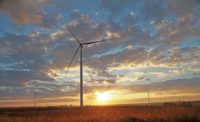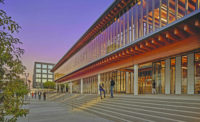ENR New York
NYSERDA: Region's Owner of the Year Propels NY’s Clean Energy Push

NYSERDA has five active offshore wind energy projects in development that, when completed, are set to push the state to the halfway point of its 9,000-MW renewable-energy capacity goal by 2035.
IMAGE COURTESY OF NYSERDA

New York Gov. Andrew Cuomo has called for the state to obtain 70% of its power from renewable sources by 2030.
PHOTO COURTESY OFFICE OF THE GOVERNOR, NEW YORK STATE

Five offshore wind projects in active development, a $1-billion solar initiative and a $2-billion, 250-mile transmission system actively being procured to link renewable power to users are among ways the New York State Energy Research and Development Authority is making a clean energy impact for contractors and the public. NYSERDA also is ramping up local energy efficiency and renewable power incentives for business owners, developers, local governments and other stakeholders, serving as the key link in Gov. Andrew Cuomo’s ambitious agenda to have 70% of the state’s electricity from renewable sources by 2030.
The unprecedented ramp-up includes a $4-billion investment in 91 large-scale renewable projects in the state and an 1,800% growth in the distributed solar sector since 2011. NYSERDA unveiled in February a three-year “strategic outlook” on efforts that combine its environmental approach for the future with what it hopes is a bold economic stimulus. “The convergence of crises in 2020 means the call to act on climate change and accelerate the energy transition has reached new levels of urgency, “ says Doreen Harris, acting president and CEO of NYSERDA since last summer.
“The convergence of crises in 2020 means the call to act on climate change and accelerate the energy transitions has reached new levels of urgency.”
—Doreen Harris, Acting President and CEO, NYSERDA
Offshore wind development is a key component. The agency has the largest U.S. offshore wind program, with the 4,300 MW now in development representing nearly half of the capacity needed to meet New York’s nation-leading goal of 9,000 MW by 2035.
In January, NYSERDA announced it will contract with Equinor Wind US LLC to develop two new offshore wind farms 20 miles off the Long Island coast, a deal New York said is the largest state renewable energy procurement in U.S. history and could generate $8.9 billion in development when completed. Set to generate 2,500 MW of carbon-free energy, it follows 1,700 MW underway since 2018 by the firm and, separately, by developer Orsted.
As part of the new project, Equinor will build an offshore wind turbine staging facility and O&M hub in Brooklyn as well as other new and expanded manufacturing in locations near Albany and Long Island. Investment will total $664 million, with the state aiming to generate $3 of private investment for each dollar it invests Equinor and the state “will create a robust offshore wind supply chain capable of manufacturing, assembling and staging these projects at scale,” said Espedal Kindem, president of the firm’s U.S. arm.
The New York State Climate Leadership and Community Protection Act calls for 6,000 MW of solar capacity by 2025, with the $1-billion solar initiative advancing project scale-up. San Diego-based developer Borrego said it will develop a 110-MW utility-scale solar project in upstate Jefferson County, its largest to date and one of 20 awards the agency made for projects around the state.
Plans are also in place to construct New York’s Green Energy Transmission Superhighway, a 250-mile, $2-billion transmission system that will connect renewable energy systems in upstate New York and Canada with downstate areas and also modernize New York’s electric grid. NYSERDA has begun soliciting proposals for the project.
Under the new Tier 4 renewable energy program. NYSERDA seeks bids for up to 1,500 MW or more of clean energy that can be "cost effectively and responsibly" delivered to New York City. Construction has started on the New York Power Authority’s 86-mile Smart Path from Massena to Croghan, and will soon begin on several key projects in western New York and in the mid-Hudson and Capital regions.
With transportation sector emissions a major greenhouse gas source, the agency will also help expand electric vehicle charging stations in New York and other electrification efforts, for which it says the state has made a $1 billion investment. Proposals submitted for the first round of the $11-million Direct Current Fast Charger program are now being evaluated.
NYSERDA also has a role to boost municipal bus fleet conversion to electric power to progress toward a goal of 100% zero-emission fleets by 2035 and is part of a $20-million initiative with the State University of New York to launch the Offshore Wind Training Institute to train 2,500 workers with the specialized skills involved in wind and renewable energy construction.
In 2020, NYSERDA also launched two statewide cleantech accelerators offering a variety of business support services, including seed money to build or grow a clean energy business to propel supply-chain development.
Energy officials in New Jersey, which also has an ambitious clean-energy agenda and seeks to be an Atlantic coast industry hub, note the need for bistate collaboration. “This has to be a regional approach,” Joe Fiordaliso, president of the state Board of Public Utilities, told ENR. “We’re all in this together.”
NYSERDA also is addressing emissions from buildings, which account for 30% of greenhouse gases produced, it says. The RetrofitNY program, cited as the first of its kind when launched in 2018, is intended to create a new industry that can deliver replicable net-zero, or near net-zero energy retrofits to residential building stock at scale. Energy efficient retrofit products designed through the program provide multi-family buildings cost-effective ways to cut emissions and reduce residents’ energy costs while making homes more comfortable, according to NYSERDA.
Meanwhile, NYSERDA’s network of contractors are optimistic about the future of clean energy construction in the state. Dave Hepinstall, executive director of the Association for Energy Affordability Inc., is a preferred agency contractor that has worked with NYSERDA since 1996. He notes work with a lot of multifamily buildings that have central heat and hot air transmission from one and two-pipe steam systems that now are being converted to electric heat with electric pumps.
“NYSERDA certainly gets the best of the best [among contractors], because not everyone is qualified.”
—Dave Hepinstall, Executive Director, Association for Energy Affordability Inc.
Hepinstall says NYSERDA “is looking for those that meet their criteria, and I think they certainly get the best of the best, because not everyone is qualified.”
He says the future of clean energy in New York depends on a lot of variables. “It’s really important now that utilities are involved in this process and that they’re being allowed to work collaboratively,” Heppinstall says. “I’m optimistic, but we have barriers in clean energy that can only be overcome with workforce development.”
Robert Sedaghatpour, president of Stratco Property Solutions, says NYSERDA presents a window of opportunity for both the short and long term. The agency “has one of the best clean energy projects overall,” he says. “There is a learning curve in doing business with them, but we’re all committed to the same goal.”
Looking more broadly at the energy transition challenge ahead, Scott R. Ceasar, senior vice president of Cosentini Associates, contends that “the largest impediment to adoption of non-fossil fuel technology in buildings is that the energy cost to heat with electric power is still significantly more expensive than heating with natural gas.”
He adds that as the New York electric grid converts to renewable sources with the help of NYSERDA funding, “the cost of power will decrease to where it will be more economical than fossil fuel combustion.”




